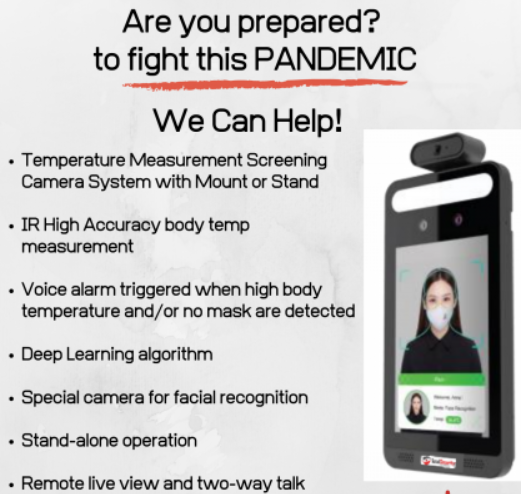5 Ways Thermal Fever Detection Cameras Can Be Used By NYC Restaurants
More and more restaurant owners in New York are realizing the importance of investing in innovative camera technology, such as Elevated Body Temperature (EBT) cameras. Restaurants, cafés, and bars that utilize fever detection cameras are more likely to stop the spread of the coronavirus.
A restaurant in New York City is less likely to endure a long-term shutdown compared to businesses that do not have a system in place to help thwart the spread of this contagious virus.
Here are 5 surefire ways to use thermal fever detection cameras for NYC restaurants:
Checking Staff Members
Whether your restaurant is open in full bloom or you are only opting for take-out and deliveries, installing a fever detection camera system will help stop the spread of the coronavirus in your restaurant.
Each employee who enters the building is checked before the start of his/her shift. If the camera detects that an employee may be at risk, you can advise the employee to seek medical attention. He or she will then be placed on a 14-day quarantine. This is an effective prevention method restaurant owners are using.
Checking Customers for Elevated Body Temperature
Restaurants have been known to be the culprits of spreading the coronavirus. However, your restaurant doesn’t have to be. Some restaurant owners are hesitant about installing EBT cameras.
They are concerned their patrons will feel camera detection for medical purposes is a total invasion of privacy. In reality, having fever detection cameras installed is becoming the norm. At some point, many restaurants throughout New York and other states will have this technology installed.
Restaurant patrons will eventually become leery about eating at restaurants that do not have a fever detection camera system in place.
If this disease escalates, stricter laws will be mandated. Not having a system in place to detect COVID-19 could become a health code violation. Are you prepared?
Checking Vendors
Restaurant vendors tend to show up at any time unannounced — whether they are making deliveries or stocking food and beverage products. Making sure they are free and clear of a fever or virus will protect you, your staff, and your customers.
Checking Contractors
The UberEats/DoorDash delivery person, and even the industrial refrigerator repair person could be potential carriers of coronavirus. Installing thermal fever detection cameras for NY restaurants is crucial.
Checking Cleaning Crew
Many restaurants hire third-party cleaning companies to come in after-hours to clean. Unless you have a good thermal fever detection system installed, there’s no way to tell if they have been infected.
These are just a handful of ways elevated body temperature cameras can be used by restaurant owners. Fever detection cameras can help provide a much safer working environment for workers, contractors, and customers.
What Is Thermal Fever Detection?
 The traditional protocol of monitoring COVID-19 is to take a person’s temperature. This is not only time-consuming, but it can also be inaccurate. Fever detection technology eliminates the hassle and worry of trying to keep your restaurant virus-free. Restaurants aren’t the only entities using this technology — corporate offices, retail stores, salons, warehouses, factories, courthouses, hospitals, and supermarkets also use them.
The traditional protocol of monitoring COVID-19 is to take a person’s temperature. This is not only time-consuming, but it can also be inaccurate. Fever detection technology eliminates the hassle and worry of trying to keep your restaurant virus-free. Restaurants aren’t the only entities using this technology — corporate offices, retail stores, salons, warehouses, factories, courthouses, hospitals, and supermarkets also use them.
Are your employees, and customers safe? Do you have an effective system in place to help prevent COVID-19?
When a restaurant doesn’t offer protection against the coronavirus, it can run the risk of exposing dozens of people. You could also open doors to lawsuits and run the risk of losing your business.
Prevent the Spread of Coronavirus By Getting Thermal Fever Detection Cameras Installed
Protect your business, restaurant patrons, employees, and everyone who enters your building by installing the necessary fever detection system.
For a quote and FREE consultation, contact Total Security. Give us a call today at (516) 775-2304.